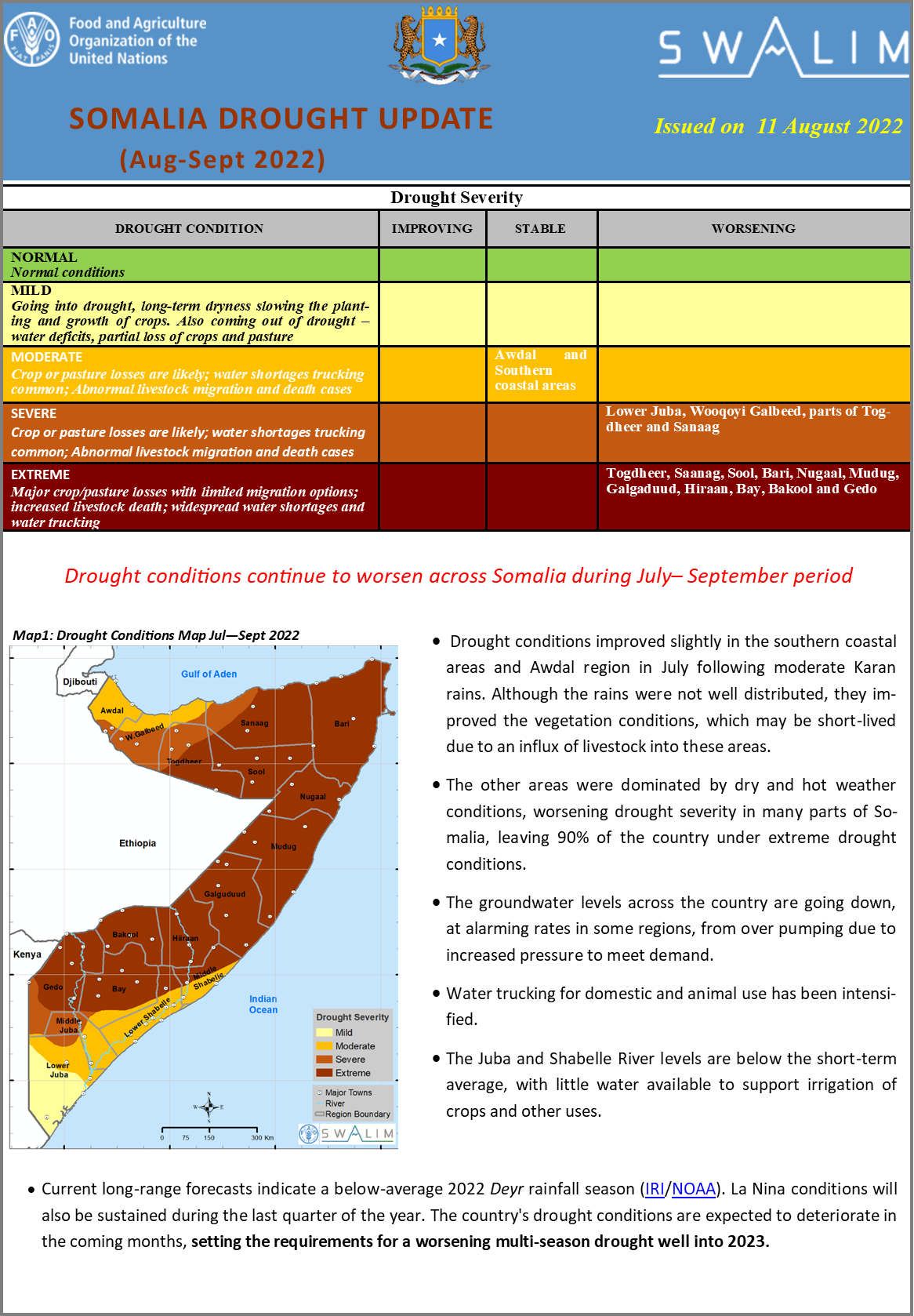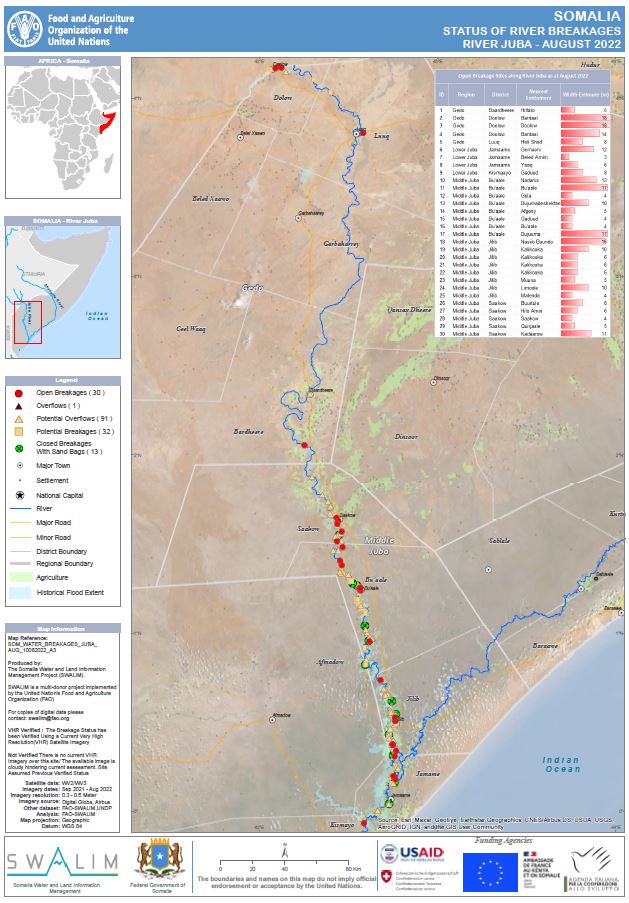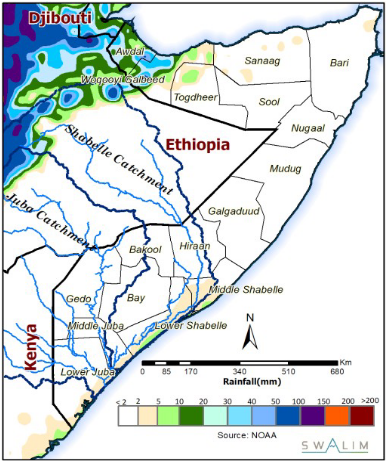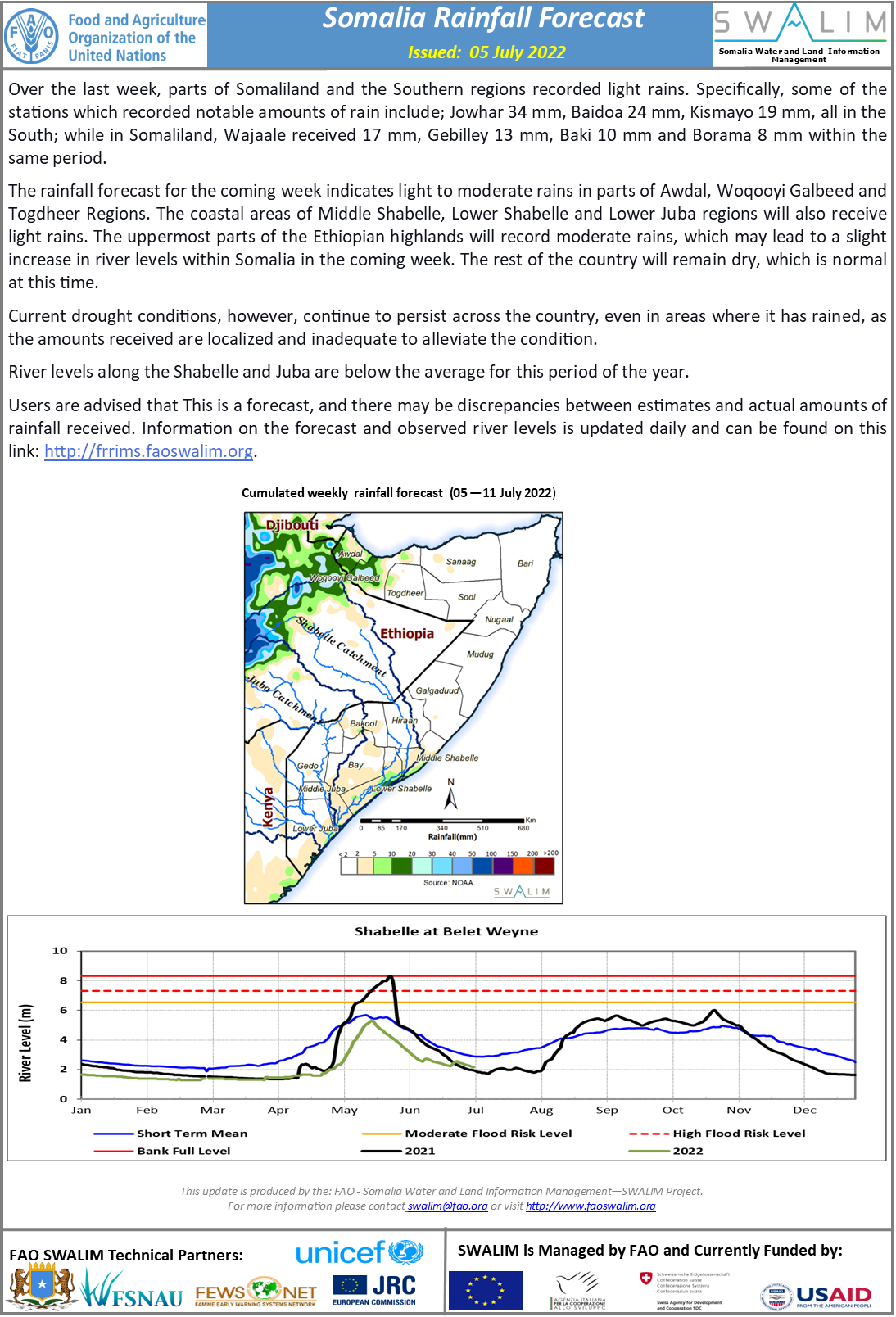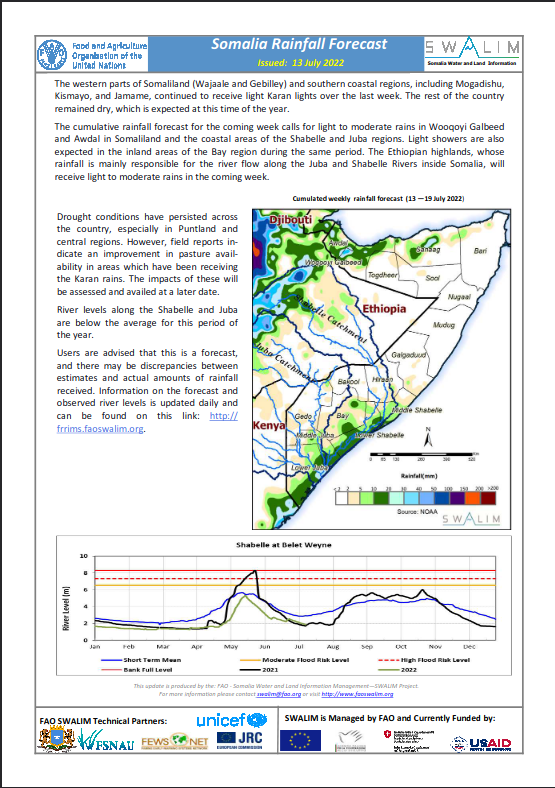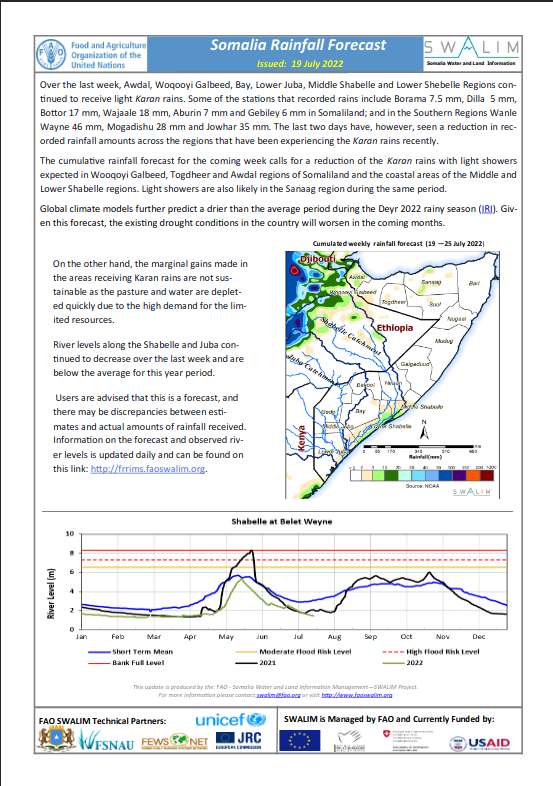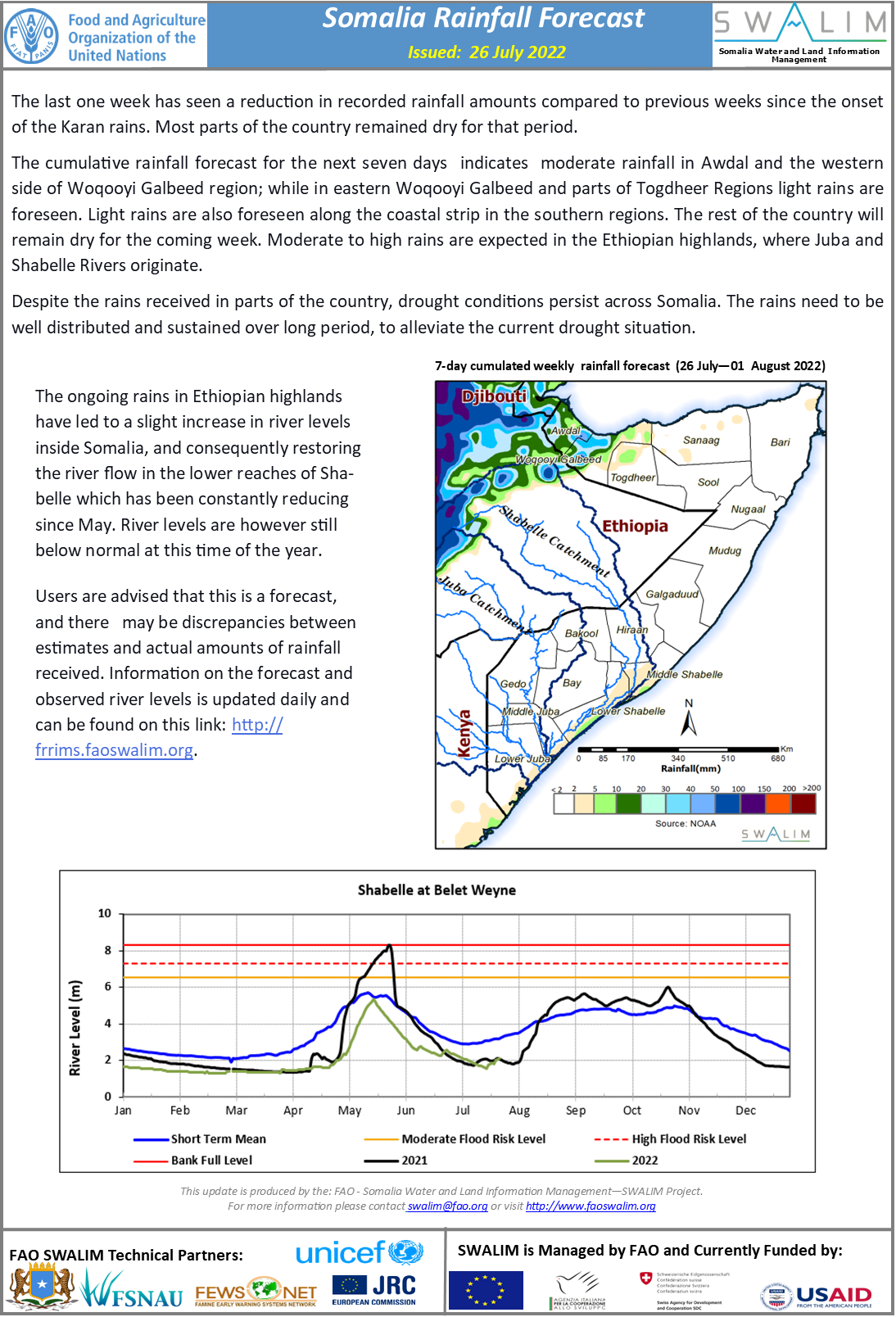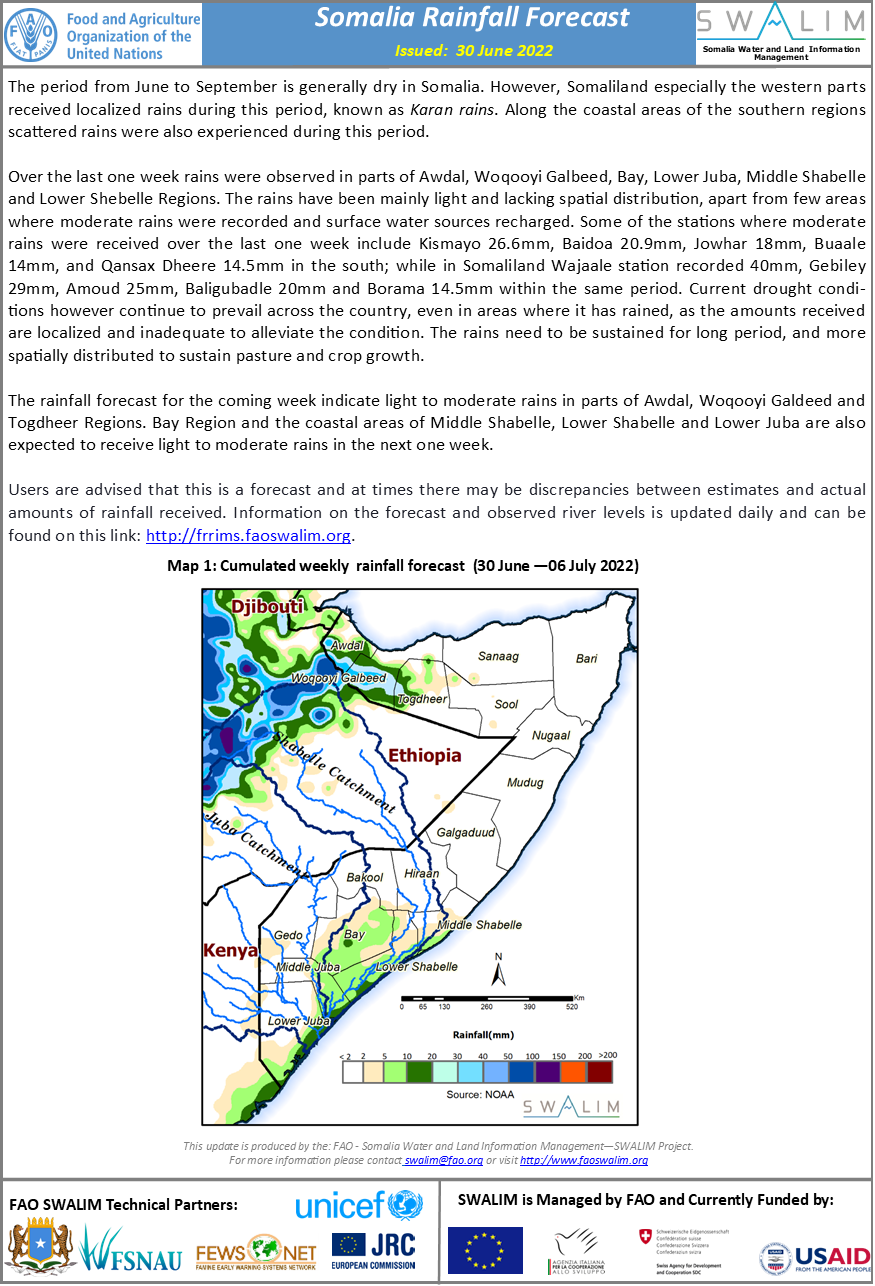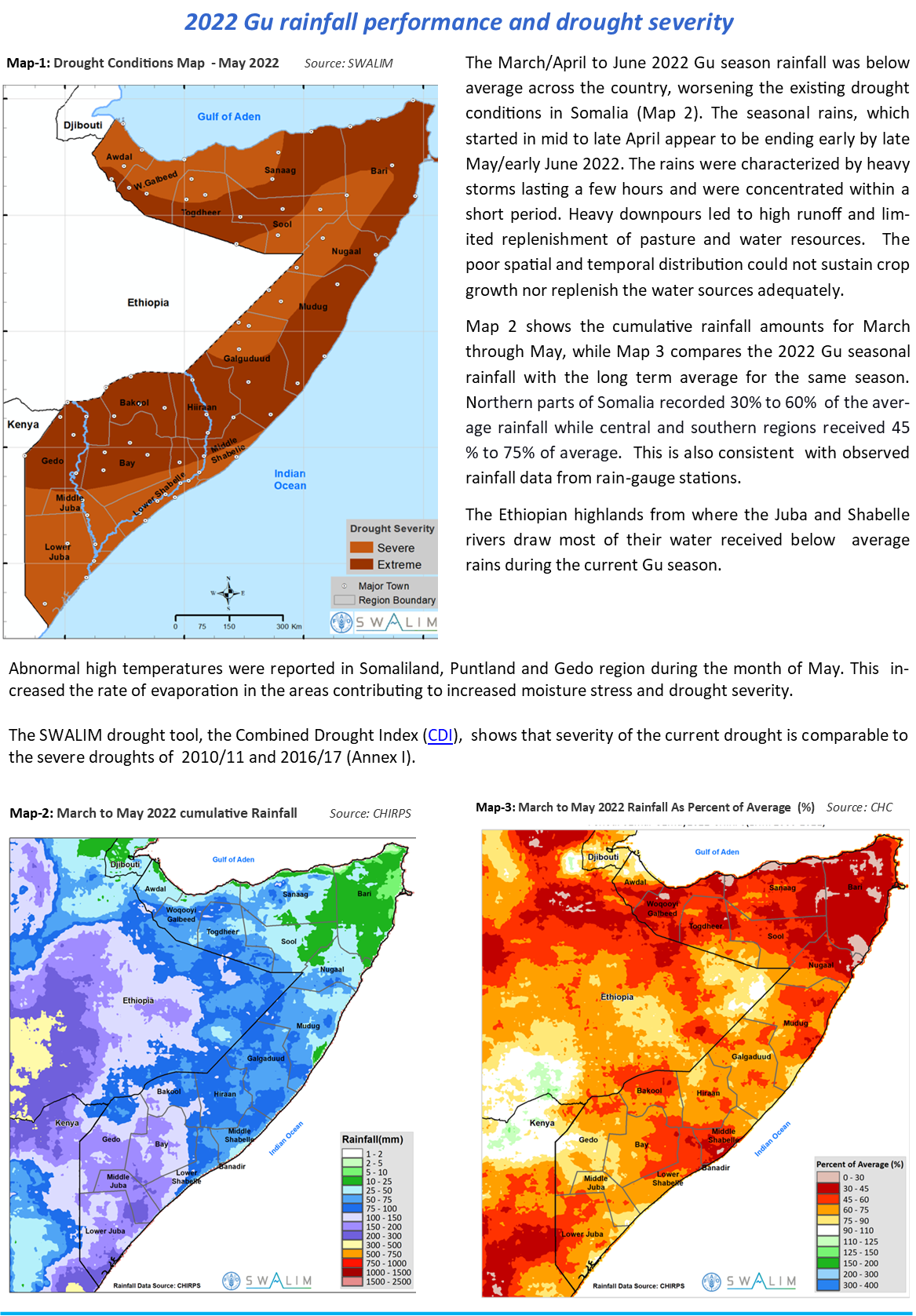Library Catalog
Latest Documents and Publications listed. Use search terms in the box below to find what you need
Somalia Rainfall Forecast – Issued 27 September 2022
Over the last two weeks, light to moderate rains have been reported in parts of Somalia, marking the onset of Deyr season. However, many parts of the country remain hot and dry.
The western parts of Somaliland continued to receive good rains over the last two weeks. Some stations that recorded good rains over this period include Amoud 162mm, Qulujeed 100mm, Aburin 84mm, Sheikh 81mm and Magalo-Cad 68mm. Bari and Nugaal Regions of Puntland also received scattered rains, with Baran station recording the highest amount of 132mm over the past two weeks. Few areas in the central and southern regions of Somalia received light rains. The rains received so far are however of minimal impact, and the country continues to experience severe drought conditions. The rains are expected to spread in time and space during the coming weeks.
The cumulative rainfall forecast for the next seven days indicates scattered light rains across the country. Few pockets of moderate rains are expected in Togdheere, Sool and Sanaag Regions. Galgadud, Bakool and Lower Juba will also receive moderate rains in few places. The Ethiopian highlands where Juba and Shabelle rivers originate will have moderate to high rains during the forecast period.
River levels along Shabelle and Juba, and which have been rising since beginning of September have slightly dropped over the last one week. The levels are currently within the short term mean for this period.
Publication Type:
Rainfall Forecast
Publication Date:
Author:
Corporate Author:
Somalia Drought Update – Issued 12 August 2022
Drought conditions improved slightly in the southern coastal areas and Awdal region in July following moderate Karan rains. Although the rains were not well distributed, they improved the vegetation conditions, which may be short-lived due to an influx of livestock into these areas.
The other areas were dominated by dry and hot weather conditions, worsening drought severity in many parts of Somalia, leaving 90% of the country under extreme drought conditions.
The groundwater levels across the country are going down, at alarming rates in some regions, from over pumping due to increased pressure to meet demand.
Water trucking for domestic and animal use has been intensified.
The Juba and Shabelle River levels are below the short-term average, with little water available to support irrigation of crops and other uses.
Publication Type:
Drought watch
Publication Date:
Author:
Corporate Author:
Status of River Breakages along Juba and Shabelle Rivers, August 2022
Four consecutive poor rainy seasons in most parts of the Horn of Africa region have resulted to current serious hydrological drought conditions in Somalia and neighboring countries.. Juba and Shabelle Rivers, with the headwaters in the Ethiopian highlands have remained below the long term average since the beginning of 2022, negatively impacting agriculture production, domestic and livestock water use for the riverine communities. The low river levels however provide an opportunity to fix the river breakages and weak embankments, ahead of the next rainy season.
SWALIM has updated the status of the river breakages along the Juba and Shabelle Rivers using available Very High Resolution (VHR) satellite imagery and a Digital Elevation Model (DEM).
Five types of breakages have been identified, namely; open, overflow, potential overflows, potential breakages and closed with sandbags. The open breakages are those that are currently open as observed on the latest VHR image available. All the observations reported refers to the latest suitable VHR satellite image available, which is indicated in the online database.
100 Open breakage points have been identified, 70 on the Shabelle River and 30 on the Juba River which require immediate action. 13 Overflows were also identified during this season. Jowhar district was worst affected along the Shabelle while Bu’aale and Jilib districts are worst affected along the Juba.
Users are advised that the methodology is biased towards Remote Sensing (RS) interpretation with only limited “ground truthing” due to access constraints. Open breakages might have been omitted in some cases where satellite images may not have been very clear (e.g. heavy cloud cover) or were not available.
Publication Type:
Map
Publication Date:
Author:
Corporate Author:
Somalia Rainfall Forecast – Issued 26 July 2022
The last one week has seen a reduction in recorded rainfall amounts compared to previous weeks since the onset of the Karan rains. Most parts of the country remained dry for that period.
The cumulative rainfall forecast for the next seven days indicates moderate rainfall in Awdal and the western side of Woqooyi Galbeed; while in eastern Woqooyi Galbeed and parts of Togdheer Regions light rains are foreseen.
Light rains are also foreseen along the coastal strip in the southern regions. The rest of the country will remain dry for the coming week. Moderate to high rains are expected in the Ethiopian highlands, where Juba and Shabelle Rivers originate.
Despite the rains received in parts of the country, drought conditions persist due across Somalia. The rains need to be well distributed and sustained over a long period, to alleviate the current drought situation.
Publication Type:
Rainfall Forecast
Publication Date:
Author:
Corporate Author:
Somalia Rainfall Forecast – Issued 05 July 2022
Over the last week, parts of Somaliland and the Southern regions recorded light rains. Specifically, some of the stations which recorded notable amounts of rain include; Jowhar 34 mm, Baidoa 24 mm, Kismayo 19 mm, all in the South; while in Somaliland, Wajaale received 17 mm, Gebilley 13 mm, Baki 10 mm and Borama 8 mm within the same period.
The rainfall forecast for the coming week indicates light to moderate rains in parts of Awdal, Woqooyi Galbeed and Togdheer Regions. The coastal areas of Middle Shabelle, Lower Shabelle and Lower Juba regions will also receive light rains. The uppermost parts of the Ethiopian highlands will record moderate rains, which may lead to a slight increase in river levels within Somalia in the coming week. The rest of the country will remain dry, which is normal at this time.
Current drought conditions, however, continue to persist across the country, even in areas where it has rained, as the amounts received are localized and inadequate to alleviate the condition.
River levels along the Shabelle and Juba are below the average for this period of the year.
Publication Type:
Rainfall Forecast
Publication Date:
Author:
Corporate Author:
Somalia Rainfall Forecast – Issued 13 July 2022
The western parts of Somaliland (Wajaale and Gebilley) and southern coastal regions, including Mogadishu, Kismayo, and Jamame, continued to receive light Karan lights over the last week. The rest of the country remained dry, which is expected at this time of the year.
The cumulative rainfall forecast for the coming week calls for light to moderate rains in Wooqoyi Galbeed and Awdal in Somaliland and the coastal areas of the Shabelle and Juba regions. Light showers are also expected in the inland areas of the Bay region during the same period. The Ethiopian highlands, whose rainfall is mainly responsible for the river flow along the Juba and Shabelle Rivers inside Somalia, will
receive light to moderate rains in the coming week.
Publication Type:
Rainfall Forecast
Publication Date:
Author:
Corporate Author:
Somalia Rainfall Forecast – Issued 19 July 2022
Over the last week, Awdal, Woqooyi Galbeed, Bay, Lower Juba, Middle Shabelle and Lower Shebelle Regions continued to receive light Karan rains. Some of the stations that recorded rains include Borama 7.5 mm, Dilla 5 mm, Bottor 17 mm, Wajaale 18 mm, Aburin 7 mm and Gebiley 6 mm in Somaliland; and in the Southern Regions Wanle Wayne 46 mm, Mogadishu 28 mm and Jowhar 35 mm. The last two days have, however, seen a reduction in recorded rainfall amounts across the regions that have been experiencing the Karan rains recently.
The cumulative rainfall forecast for the coming week calls for a reduction of the Karan rains with light showers expected in Wooqoyi Galbeed, Togdheer and Awdal regions of Somaliland and the coastal areas of the Middle and Lower Shabelle regions. Light showers are also likely in the Sanaag region during the same period.
Publication Type:
Rainfall Forecast
Publication Date:
Author:
Corporate Author:
Somalia Rainfall Forecast – Issued 26 July 2022
The last one week has seen a reduction in recorded rainfall amounts compared to previous weeks since the onset of the Karan rains. Most parts of the country remained dry for that period.
The cumulative rainfall forecast for the next seven days indicates moderate rainfall in Awdal and the western side of Woqooyi Galbeed region; while in eastern Woqooyi Galbeed and parts of Togdheer Regions light rains are foreseen. Light rains are also foreseen along the coastal strip in the southern regions. The rest of the country will remain dry for the coming week. Moderate to high rains are expected in the Ethiopian highlands, where Juba and Shabelle Rivers originate.
Despite the rains received in parts of the country, drought conditions persist across Somalia. The rains need to be well distributed and sustained over long period, to alleviate the current drought situation.
The ongoing rains in Ethiopian highlands have led to a slight increase in river levels inside Somalia, and consequently restoring the river flow in the lower reaches of Shabelle which has been constantly reducing since May. River levels are however still below normal at this time of the year.
Publication Type:
Rainfall Forecast
Publication Date:
Author:
Corporate Author:
Somalia Rainfall Forecast – Issued 30 June 2022
The period from June to September is generally dry in Somalia. However, Somaliland especially the western parts received localized rains during this period, known as Karan rains. Along the coastal areas of the southern regions scattered rains were also experienced during this period.
Over the last one week rains were observed in parts of Awdal, Woqooyi Galbeed, Bay, Lower Juba, Middle Shabelle and Lower Shebelle Regions. The rains have been mainly light and lacking spatial distribution, apart from few areas where moderate rains were recorded and surface water sources recharged. Some of the stations where moderate rains were received over the last one week include Kismayo 26.6mm, Baidoa 20.9mm, Jowhar 18mm, Buaale 14mm, and Qansax Dheere 14.5mm in the south; while in Somaliland Wajaale station recorded 40mm, Gebiley 29mm, Amoud 25mm, Baligubadle 20mm and Borama 14.5mm within the same period. Current drought conditions however continue to prevail across the country, even in areas where it has rained, as the amounts received are localized and inadequate to alleviate the condition. The rains need to be sustained for long period, and more spatially distributed to sustain pasture and crop growth.
The rainfall forecast for the coming week indicate light to moderate rains in parts of Awdal, Woqooyi Galdeed and Togdheer Regions. Bay Region and the coastal areas of Middle Shabelle, Lower Shabelle and Lower Juba are also expected to receive light to moderate rains in the next one week.
Publication Type:
Rainfall Forecast
Publication Date:
Author:
Corporate Author:
Somalia Drought Update and GU 2022 Rainfall Performance – Issued 14 June 2022
The 2022 Gu rainy season in Somalia came to an early end in May, with depressed rainfall amounts recorded and forecasts indicating little to no rainfall through mid-June . The overall seasonal rainfall performance was poor. The northern areas recorded 30% to 60% of the average rainfall while the central and southern areas received 45 % to 75%. This marks a fourth consecutive failed rainy season since late 2020.
Gu season rainfall has moderated drought conditions in most parts of the country as it replenished pasture and water resources. However, this improvement is expected to be short-lived as and drought conditions are expected to worsen throughout the prolonged dry Hagaa (July-September) dry season.
Current climate forecasts indicate a 62 per cent chance of La Niña during the June to August 2022 period (IRI). La Niña is generally associated with drought conditions in the Horn of Africa region, including Somalia. The next seasonal rains are not expected until mid-October and available long-range forecasts indicate that a record fifth below-average rainy season is likely across Somalia during the forthcoming October and December 2022 Deyr season. This could set the conditions for a worsening multi-season drought well into 2023.
More than 80 per cent of Somalia is currently facing severe to extreme drought conditions. The drought severity levels are comparable to that of 2010/11 and 2016/17 as seen in Annex I.
Water resources are expected to decline drastically during the forthcoming dry season as water demand and use increases. In Garowe, there was abnormal drop in ground water level of seven meters between October 2021 and May 2022 (Annex II).
The Juba and Shabelle River levels are currently 30 percent below the short-term average, with limited water available to support irrigation of crops and other uses. The river levels are expected to decrease further in the coming weeks and months.
The vegetation conditions that had improved in some areas as a results of the Gu season rains are expected to be depleted soon due to the low level of biomass recovery and likely influx of livestock into these areas. The Prospects for Gu season cereal production remain bleak, with crop failure expected in many areas . Due to the poor rains, some communities did not plant during this season. Dry and hot conditions will continue across most parts of the country during this dry Haggai (June/July-September ) season except for parts of Somaliland that will receive moderate Karan rains.
With no significant rains foreseen until the next rainy season in October, and the La Nina predictions, the current drought situation will deteriorate further in Somalia. The negative trends are not expected to reverse until the arrival of Deyr (Oct-Dec) 2022 rains. However, the preliminary forecast for the Deyr 2022 season is also below average—FEWSNET
Publication Type:
Drought watch
Publication Date:
Author:
Corporate Author:
Pages
 RSS feed [compliant with the Agris AP] |
RSS feed [compliant with the Agris AP] |  Agris AP XML
Agris AP XML



